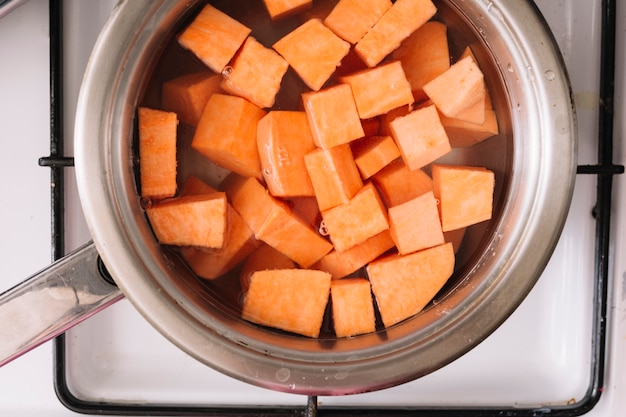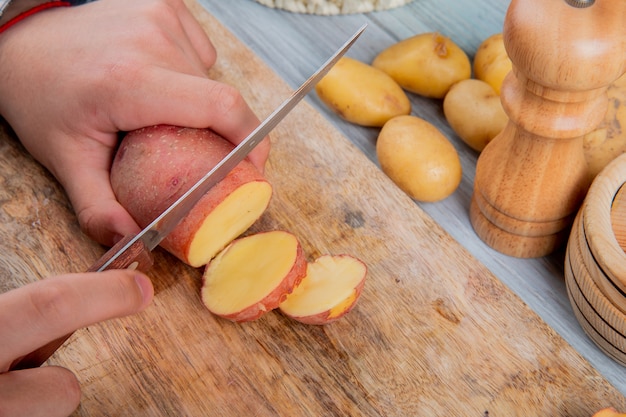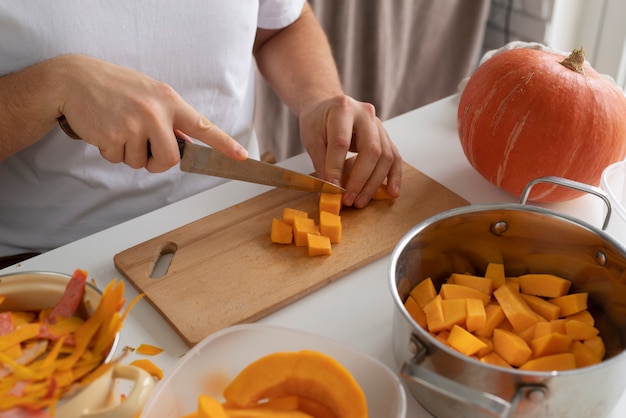Ah, sweet potatoes. Those humble, orange root vegetables are a true kitchen staple, bringing warmth and sweetness to countless dishes. They're versatile, affordable, and downright delicious, whether roasted for a side dish, whipped into a creamy mash, or simmering in a hearty stew. But, you know what? Getting the cooking temperature right is absolutely crucial. It's the difference between a perfectly cooked, soft, and sweet potato and one that's dry, hard, and frankly, a disappointment.
Over the years, I've cooked my fair share of sweet potatoes. I've experimented with different methods, ovens, and temperatures, always striving for that perfect result. I've even had my fair share of mishaps (who hasn't had a slightly burnt sweet potato at some point?). But, through trial and error, I've learned a thing or two about achieving that sweet potato perfection, and I'm excited to share those secrets with you. So, grab a cozy cuppa, settle in, and let's delve into the fascinating world of sweet potato cooking temperatures.
(Part 1) Understanding the Sweet Potato

Why Temperature Matters: The Delicate Nature of Sweet Potatoes
Think of a sweet potato as a delicate treasure. You need to treat it with care to unlock its full potential. Too low a temperature, and it'll take forever to cook, potentially drying it out. Too high, and you risk scorching the outside while the inside remains raw. The perfect temperature range allows the sweet potato to cook evenly, retaining its moisture and developing that signature sweet flavor.
sweet potato varieties: Beyond the Classic Orange
Let's talk about the different types of sweet potatoes you might encounter. You've got your classic orange sweet potato, the one you probably grew up with. But there are also other varieties, each with its unique charm:
- Purple Sweet Potatoes: These beauties boast vibrant purple flesh and a slightly earthy flavor, adding a splash of color and a subtle depth to your dishes.
- japanese sweet potatoes: Often smaller and sweeter than their orange counterparts, Japanese sweet potatoes are ideal for baking or roasting, delivering an intensely sweet and delicate flavor.
- Yellow Sweet Potatoes: With their bright yellow flesh and mildly sweet flavor, yellow sweet potatoes are a versatile option for a variety of culinary applications.
The variety you choose will influence how you cook it and the temperature you'll need. For example, smaller, Japanese sweet potatoes often require a slightly lower temperature and shorter cooking time than larger orange sweet potatoes. Don't be afraid to experiment with different varieties to discover your favorite!
(Part 2) Roasting: The Classic Method for Sweet Potatoes

The Ideal Oven Temperature for roasting sweet potatoes
Roasting is arguably the most popular way to cook sweet potatoes. It's simple, hands-off, and delivers a wonderfully caramelized exterior and a soft, fluffy interior. The ideal oven temperature for roasting sweet potatoes is between 400°F and 425°F (200°C and 220°C). This range allows the sweet potatoes to cook quickly without burning, resulting in a perfectly cooked potato.
Factors Affecting roasting time: A Guide to Perfect Timing
Here are a few factors that can influence how long your sweet potatoes need to roast:
- Size Matters: Smaller sweet potatoes cook faster than larger ones. A medium-sized sweet potato will typically roast in 30-45 minutes, while a large one might need 45-60 minutes.
- Thickness: Roasting whole sweet potatoes will take longer than roasting them cut into smaller pieces. Think of it like this: more surface area means quicker cooking.
- Oven Type: Different ovens can have slightly different heating capabilities, so your roasting time might vary. Always check your sweet potatoes early and adjust the time accordingly.
- Skin On or Off: Roasting sweet potatoes with their skin on will take longer than roasting them peeled. The skin acts as a barrier, slowing down the cooking process.
roasting tips: Elevate Your Sweet Potato Game
To ensure perfectly roasted sweet potatoes, consider these tips:
- Toss with Oil and Seasonings: A drizzle of olive oil and a sprinkle of salt and pepper will enhance the flavor and help create a beautiful golden-brown crust. Get creative with your seasonings! Try a pinch of cinnamon, nutmeg, or chili powder for a flavor twist.
- Use a Baking Sheet: This allows the heat to circulate around the sweet potatoes, ensuring even cooking. Don't overcrowd the pan! Give the sweet potatoes space to breathe and cook evenly.
- Flip Them Over: Flip the sweet potatoes halfway through the cooking time to ensure even browning on all sides.
(Part 3) The Art of baking sweet potatoes: A Gentle Approach

Baking Temperature: A Slower, More Tender Result
While roasting offers a quick and efficient method, baking provides a more gentle approach. This method is perfect for creating a soft, tender sweet potato, especially if you're using smaller varieties. A typical baking temperature for sweet potatoes is between 350°F and 375°F (175°C and 190°C). This lower temperature allows the sweet potato to cook gradually, resulting in a truly melt-in-your-mouth texture.
baking tips: Ensure Success with These Simple Techniques
Here are a few tips to help you bake perfect sweet potatoes:
- Prick the Skin: This helps prevent steam buildup and potential explosions in the oven. It also allows the heat to penetrate the potato more evenly.
- Use a Baking Dish: A baking dish provides a more contained environment for baking sweet potatoes. It also helps prevent the sweet potato from sticking to the oven rack.
- Don't Overcrowd: Give the sweet potatoes space to breathe and cook evenly. If you're baking several sweet potatoes, consider using two baking dishes.
- Wrap in Foil: For an extra-tender sweet potato, wrap the potato in aluminum foil. This will help retain moisture and prevent the potato from drying out.
(Part 4) boiling sweet potatoes: A Simple and Versatile Method
Boiling Point: The Key to Tender, Versatile Sweet Potatoes
Boiling sweet potatoes is a quick and easy way to cook them, making them perfect for preparing sweet potatoes for mashing or adding them to soups and stews. The ideal water temperature for boiling sweet potatoes is 212°F (100°C), which is the boiling point of water.
Boiling Techniques: Optimize Your Sweet Potato Experience
Here are some boiling tips to help you create perfectly cooked sweet potatoes:
- Uniform Pieces: Cut the sweet potatoes into uniform pieces to ensure they cook evenly.
- Salt the Water: Adding salt to the water helps season the sweet potatoes and enhances their flavor.
- Check for Doneness: Use a fork to check for doneness. A fork should easily pierce the sweet potato when it's cooked through.
- Don't Overcook: Overcooked sweet potatoes can become mushy. Keep an eye on the cooking time and remove the sweet potatoes from the water as soon as they are tender.
(Part 5) Microwave: A Quick and Convenient Option
Microwave Temperature and Power: Navigating the Microwave
When you're short on time, the microwave can be a lifesaver, allowing you to quickly cook sweet potatoes. However, it's important to watch them closely to avoid overcooking. Microwave ovens vary in power, but a typical setting for cooking sweet potatoes is high power (1000 watts).
microwave cooking Times: A Guide to Quick Sweet Potato Cooking
The cooking time for sweet potatoes in the microwave will vary depending on their size. Here's a general guide:
| Size of Sweet Potato | Microwave Time |
|---|---|
| Small (4 inches long) | 3-5 minutes |
| Medium (6 inches long) | 5-8 minutes |
| Large (8 inches long) | 8-12 minutes |
Remember, these are just estimates. It's always best to check the sweet potato for doneness after the minimum time.
Microwave Tips: Maximizing Your Microwave Experience
Here are a few tips to make microwave cooking a breeze:
- Prick the Skin: Pricking the skin allows steam to escape, preventing explosions in the microwave.
- Wrap in Paper Towels: Wrapping the sweet potato in paper towels helps absorb excess moisture and prevents splattering in the microwave.
- Check for Doneness: The sweet potato will be cooked through when it is soft and easily pierced with a fork.
- Let Cool: Let the sweet potato cool slightly before handling, as it will be hot.
(Part 6) sweet potato mash: A Creamy Delight
mashed sweet potato: The Ultimate comfort food
Mashed sweet potatoes are a classic comfort food, offering a creamy, sweet, and utterly irresistible experience. They're perfect as a side dish, a topping for baked chicken or fish, or even as a base for sweet potato fries.
Tips for Perfect Mashed Sweet Potatoes: Elevate Your Mash
To create the ultimate mashed sweet potato, consider these tips:
- Boiling or Roasting Method: These methods produce a soft, tender sweet potato, perfect for mashing.
- Add Butter or Milk: This will add richness and creaminess to the mash. For a dairy-free option, use coconut milk or a plant-based butter alternative.
- Season Generously: Salt, pepper, and a touch of nutmeg or cinnamon can elevate the flavor. Don't be afraid to experiment with other spices, such as ginger, cardamom, or allspice, for a unique twist.
- Mash with a Fork or Potato Masher: For a slightly chunky texture, use a fork. For a smooth and creamy mash, use a potato masher.
(Part 7) Sweet Potato Fries: A Crispy Treat
Sweet Potato Fries: A Delicious and Versatile Side Dish
Sweet potato fries are a crowd-pleaser, offering a crispy, flavorful, and delightful alternative to regular fries. Enjoy them as a side dish, a snack, or even as a topping for burgers and salads.
The Right Temperature for crispy fries: Achieving That Perfect Crunch
The key to perfectly crispy sweet potato fries is to cook them at a high temperature. Aim for an oven temperature of 400°F to 425°F (200°C to 220°C). This high temperature will ensure that the fries cook quickly and develop a crispy exterior.
Tips for the best sweet potato fries: Maximize Your Fries
- Evenly Sized Strips: Cut the sweet potatoes into even-sized strips to ensure they cook evenly.
- Toss with Oil and Seasonings: This will create a crispy crust and add flavor. Olive oil is a good choice, but you can also use avocado oil or coconut oil.
- Bake or Fry Them: Both methods work well for sweet potato fries. Baking offers a healthier option, while frying delivers a crispier result.
- Don't Overcrowd: Give the fries space to cook evenly. If you're making a large batch, cook them in two batches to ensure they cook evenly and achieve that perfect golden-brown color.
- Shake the Pan: Shake the pan halfway through the cooking time to ensure the fries cook evenly and don't stick.
(Part 8) sweet potato recipes: Inspiration for Your Kitchen
Sweet potato soup: A Warm and Hearty Comfort
There's something so comforting about a warm bowl of sweet potato soup. It's creamy, flavorful, and perfect for a cold day. You can make it with a variety of ingredients, such as coconut milk, ginger, and cinnamon, for a delicious and satisfying meal.
sweet potato pie: A Classic Thanksgiving Treat
Sweet potato pie is a Thanksgiving staple, but it's delicious any time of year. It's a sweet, spiced dessert that's sure to please. You can make it with a traditional crust or a graham cracker crust, adding a pecan topping for a truly decadent experience.
Sweet Potato Chili: A Flavorful and Healthy Dinner
Sweet potato chili is a unique and flavorful twist on the classic chili. It's packed with vegetables and protein, making it a healthy and satisfying meal. You can add beans, corn, and other toppings to your liking.
Sweet potato bread: A Delicious and Moist Bread
sweet potato bread is a moist and flavorful bread that's perfect for breakfast, brunch, or dessert. It's often made with spices such as cinnamon, nutmeg, and ginger, adding warmth and complexity to the flavor.
(Part 9) FAQs: Your Sweet Potato Cooking Questions Answered
FAQs: Your Sweet Potato Cooking Questions Answered
1. Can I use a thermometer to check the doneness of sweet potatoes?
Absolutely! A thermometer is a great tool for ensuring that your sweet potatoes are cooked through. For a roasted sweet potato, the internal temperature should be around 200°F to 210°F (93°C to 99°C). For boiled sweet potatoes, the internal temperature should be around 165°F to 170°F (74°C to 77°C).
2. Can I cook sweet potatoes from frozen?
Yes, you can cook sweet potatoes from frozen. Just add a few minutes to your cooking time. For example, if a recipe calls for 20 minutes of roasting time for fresh sweet potatoes, you might need to roast frozen sweet potatoes for 25-30 minutes. It's always best to check the sweet potatoes for doneness early and adjust the cooking time accordingly.
3. How do I know if a sweet potato is bad?
A bad sweet potato will have a soft, mushy texture and may have mold growing on the skin. It will also have a sour or off-putting smell. If you notice any of these signs, it's best to discard the sweet potato.
4. How long can I store sweet potatoes?
Sweet potatoes can be stored at room temperature for up to two weeks. If you need to store them for longer, you can keep them in the refrigerator for up to a month. Just make sure to keep them in a cool, dark place and avoid exposing them to direct sunlight.
5. How can I prevent sweet potatoes from getting too dry?
To prevent sweet potatoes from getting too dry, it's important to cook them at the right temperature and for the appropriate amount of time. If you're roasting or baking sweet potatoes, you can also wrap them in aluminum foil to help retain moisture.
There you have it! A comprehensive guide to sweet potato cooking temperatures. Remember, the key to delicious sweet potatoes is understanding the different cooking methods, knowing the ideal temperature ranges, and paying attention to the details. So, next time you're in the kitchen, don't be afraid to experiment with different techniques and discover your own perfect sweet potato recipe. Happy cooking!
Everyone is watching

Corn on the Cob: The Ultimate Guide to Perfectly Cooked Ears
Healthy MealsAh, corn on the cob. Just the name evokes images of sunny days, barbecues, and that sweet, juicy flavour that ...

Perfect Pork Roast Oven Cooking Time: A Guide to Delicious Results
Healthy MealsThere's something truly satisfying about a perfectly roasted pork. The aroma alone is enough to make your mout...

Ham Cooking Time: How Long to Bake, Smoke, or Boil a Delicious Ham
Healthy MealsAh, ham. It's a classic, isn't it? A real crowd-pleaser, especially around holidays. And when done right, it'...

Scallops: The Ultimate Guide to Perfect Cooking
Healthy MealsAh, scallops. Those delicate, sweet, and utterly delicious morsels of the sea. They hold a special place in my...

Spaghetti Squash: The Ultimate Guide to Cooking and Serving
Healthy MealsRemember that time you saw spaghetti squash at the supermarket, looking all bumpy and strange, and thought, "W...
